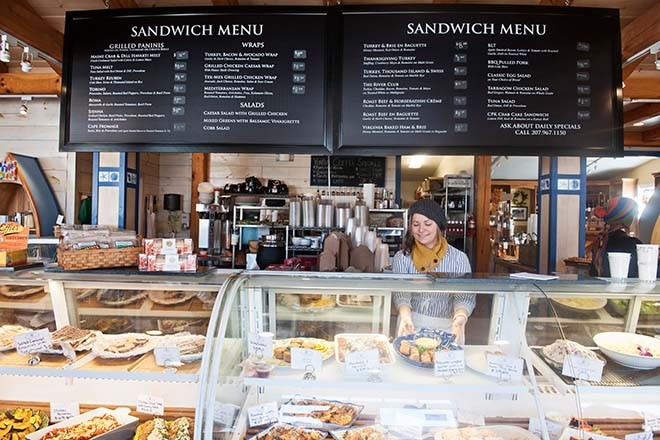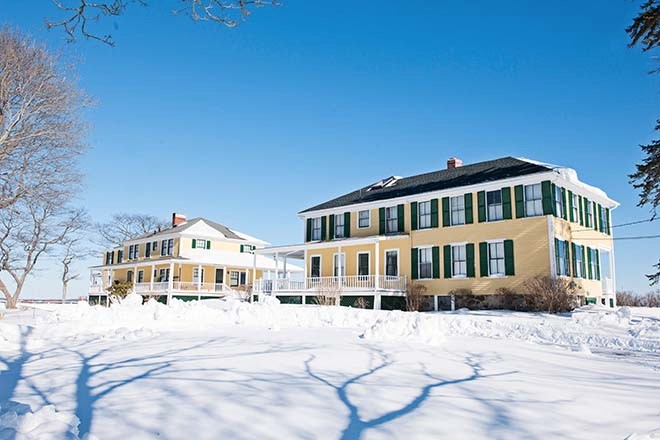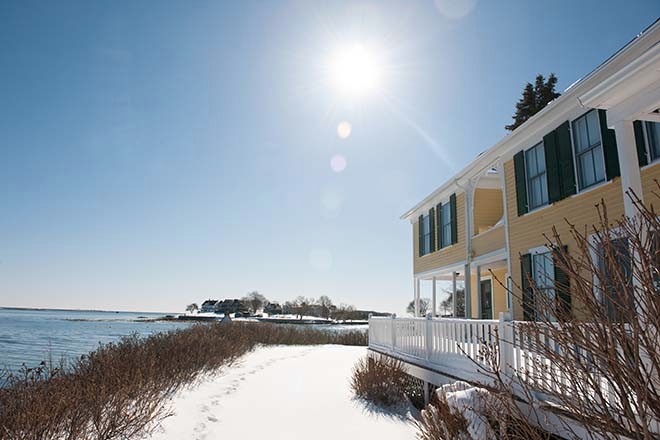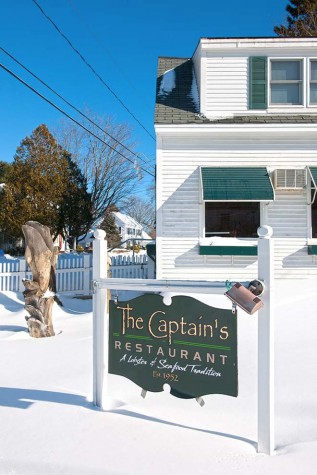Kennebunkport: A Quiet Harbor Hideaway
PORTRAIT OF PLACE
For love of a fishing hamlet in Kennebunkport
Down a winding country road, away from the hubbub of Dock Square in Kennebunkport, there’s a village called Cape Porpoise. In some ways, there isn’t much to it. Just before Route 9 makes its sharp turn north you’ll pass the creamery, a fire station, and a weathered market called Bradbury Brothers, which is also the post office. From the four-way stop at the center of the village you’ll see Cape Porpoise Kitchen and maybe, if you squint, the soup-of-the-day specials written on the chalkboard out front—today there’s clam chowder, tomato fennel, and cream of mushroom. The Wayfarer Restaurant (say hi to Bert if you stop by) is just around the corner, and to the right is Atlantic Hall, home of the library and an “ongoing book sale,” according to the handwritten note tacked inside the window.
Behind Atlantic Hall, down Langsford Lane, is the white-steepled church that chimes at 8:45. It is Sunday morning. Along the road, people are parking their rusted-out trucks and Mercedes, setting heels and boots down on gravel, and walking, coats open to the warming air, toward the church. Through my open window I hear two men greet one another, watch them shake hands and catch up over steaming cups of coffee in front of Cape Porpoise Kitchen. Instead of turning left along Route 9 toward Goose Rocks Beach or right down Langsford Lane, I continue straight down Pier Road. If you’ve never been out this way—or even if you have—I suggest you do the same. No amount of description does this drive justice.
The first slice of stunning happens just around the bend, at the root of the peninsulas hugging Cape Porpoise Harbor, where the narrow road creeps right along the water. It continues past quaint home after grand home after quaint home—all with dream-home views—across a bridge to Bickford Island, where it ends at the working pier cluttered with lobster traps, and often fishermen, their trucks, and a dog or two.
I take a seat on one of the benches looking out to Goat Island Light and breathe in the fishy air, wishing it were summer and that I had access to someone’s dinghy. I’ve heard stories about Kennebunkport kids paddling out to the islands clustered around the mouth of the bay, spending afternoons getting into the kind of trouble we’re all a little nostalgic for. The pier is also the site of the restaurant Pier 77 and its quirky counterpart, the Ramp, where for the cost of a cold beer and a bowl of mussels a person can watch the sunset over the boat-filled harbor. Dozens of fishing boats fill this water, which is never quite the expected color. On this early spring day it’s a chilly teal, but I’ve seen the water reflecting pink, or sparkling like a bay full of sapphires.
“To me, the most important part of Cape Porpoise is the pier,” Danielle Dignan tells me. Her family has lived in Cape Porpoise since the late nineteenth century, and now the village is filled with relatives of varying degrees, close to distant. Some, like Dignan, come for the summer, while others live in Cape Porpoise year-round. For all of them, it is a home in the world. “You always know what the tide is doing,” she goes on. “At high tide we were sailing. At low tide, we were running around in the mud flats where we’d been jumping off the boat hours earlier.”
Dignan tells me that Cape Porpoise has changed over the years—that it is more crowded now than it was when she was a girl—but surely kids have been playing according to the tides for centuries. Everyone does. Growing up, Kennebunk resident Geoff Bowley remembers packing a picnic and setting off with his family to the islands when the moment was right, dropping anchor in the protection of Stage Harbor, and returning home after the lobster had been eaten, when the tide told them to. Bowley, of Bowley Builders, recently remodeled Dignan’s family house, spending months at work at the water’s edge. “Because of the tides, the view is constantly changing.” While the beaches of the Kennebunks are relatively static, Cape Porpoise appeals to people who are inclined to sit, watch, and enjoy the changing look of the water around them on nearly all sides. “In southern Maine, Cape Porpoise is the closest you’re going to get to the fishing hamlets in the midcoast or downeast,” says Bowley, but we agree that there’s something special about this particular harbor, something specifically Kennebunkport about the soft light that opens and closes summer days here.
The village owes its name to Captain John Smith, who landed there in 1614. Fishing was the main occupation here for hundreds of years; it wasn’t until the late 1800s that the area began to attract summer visitors and hotels and summer homes were built along the shore. Although the last hotel shut down in the 1950s or 1960s, it is still easy to spot throwbacks to this boom time: wooden houses with deep, wraparound porches and massive oaks casting their centuries-old shade on grassy lawns. Due in part to Kennebunkport’s proximity to Boston and Portland, since the twentieth century Cape Porpoise has become home to more and more retirees, artists, and people working in a variety of professions. Many work from home, and others make somewhat lengthy but not unheard-of commutes. Newer homes fit in aesthetically, mostly updated twists on Capes, colonials, and other classic designs. “The fishermen and farmers had it right,” says Bowley, and just about everyone in Cape Porpoise seems to agree. Some of the largest homes can be seen hanging out at the ocean’s edge and are found tucked away down residential drives. There are also small homes in the trees—cabin-like dwellings and capes with windows lined with seashells and starfish and blue antique bottles. A barn sign reading “Ye Old Kings Highway 1653” intrigues me endlessly, along with more straightforward plaques like “Stone Homestead, 1735–1850.”
I drive back down Pier Road and up Langsford, past the church, a big red barn, dilapidated lobster huts. The old saltbox homes and Capes I’d admired from the facing peninsula are arranged at varying distances to the shore; some are reached by winding dirt paths and others rise up among fields of cattails. At the end of Langsford, I arrive at another edge on the Atlantic, find new perspective on the same islands. It must be impossible to grow tired of this view.
You see, it’s small in its way, a couple bulbs of land planted on the southern coast of Maine, a village of a few restaurants, a post-office-cum-market, and a few other community gathering places. But Cape Porpoise is also the manifestation of an idea of Maine that people all over the place are counting on, holding on to for their various reasons. It is truly, purely, a beautiful harbor, and that snaking drive to the pier is one of the most enchanting any of us has ever taken.
































































